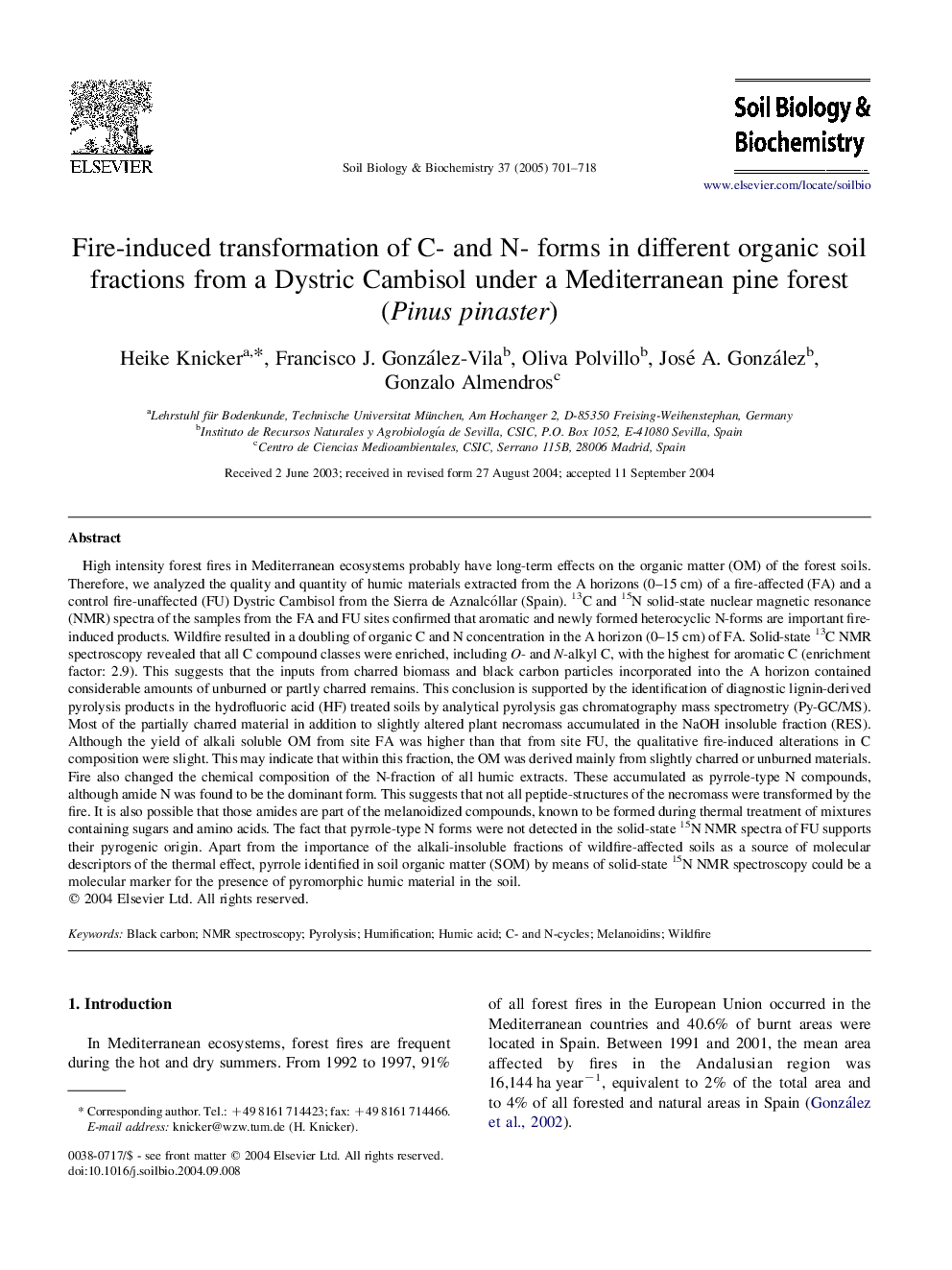| کد مقاله | کد نشریه | سال انتشار | مقاله انگلیسی | نسخه تمام متن |
|---|---|---|---|---|
| 10846290 | 1070047 | 2005 | 18 صفحه PDF | دانلود رایگان |
عنوان انگلیسی مقاله ISI
Fire-induced transformation of C- and N- forms in different organic soil fractions from a Dystric Cambisol under a Mediterranean pine forest (Pinus pinaster)
دانلود مقاله + سفارش ترجمه
دانلود مقاله ISI انگلیسی
رایگان برای ایرانیان
کلمات کلیدی
موضوعات مرتبط
علوم زیستی و بیوفناوری
علوم کشاورزی و بیولوژیک
دانش خاک شناسی
پیش نمایش صفحه اول مقاله

چکیده انگلیسی
High intensity forest fires in Mediterranean ecosystems probably have long-term effects on the organic matter (OM) of the forest soils. Therefore, we analyzed the quality and quantity of humic materials extracted from the A horizons (0-15Â cm) of a fire-affected (FA) and a control fire-unaffected (FU) Dystric Cambisol from the Sierra de Aznalcóllar (Spain). 13C and 15N solid-state nuclear magnetic resonance (NMR) spectra of the samples from the FA and FU sites confirmed that aromatic and newly formed heterocyclic N-forms are important fire-induced products. Wildfire resulted in a doubling of organic C and N concentration in the A horizon (0-15Â cm) of FA. Solid-state 13C NMR spectroscopy revealed that all C compound classes were enriched, including O- and N-alkyl C, with the highest for aromatic C (enrichment factor: 2.9). This suggests that the inputs from charred biomass and black carbon particles incorporated into the A horizon contained considerable amounts of unburned or partly charred remains. This conclusion is supported by the identification of diagnostic lignin-derived pyrolysis products in the hydrofluoric acid (HF) treated soils by analytical pyrolysis gas chromatography mass spectrometry (Py-GC/MS). Most of the partially charred material in addition to slightly altered plant necromass accumulated in the NaOH insoluble fraction (RES). Although the yield of alkali soluble OM from site FA was higher than that from site FU, the qualitative fire-induced alterations in C composition were slight. This may indicate that within this fraction, the OM was derived mainly from slightly charred or unburned materials. Fire also changed the chemical composition of the N-fraction of all humic extracts. These accumulated as pyrrole-type N compounds, although amide N was found to be the dominant form. This suggests that not all peptide-structures of the necromass were transformed by the fire. It is also possible that those amides are part of the melanoidized compounds, known to be formed during thermal treatment of mixtures containing sugars and amino acids. The fact that pyrrole-type N forms were not detected in the solid-state 15N NMR spectra of FU supports their pyrogenic origin. Apart from the importance of the alkali-insoluble fractions of wildfire-affected soils as a source of molecular descriptors of the thermal effect, pyrrole identified in soil organic matter (SOM) by means of solid-state 15N NMR spectroscopy could be a molecular marker for the presence of pyromorphic humic material in the soil.
ناشر
Database: Elsevier - ScienceDirect (ساینس دایرکت)
Journal: Soil Biology and Biochemistry - Volume 37, Issue 4, April 2005, Pages 701-718
Journal: Soil Biology and Biochemistry - Volume 37, Issue 4, April 2005, Pages 701-718
نویسندگان
Heike Knicker, Francisco J. González-Vila, Oliva Polvillo, José A. González, Gonzalo Almendros,